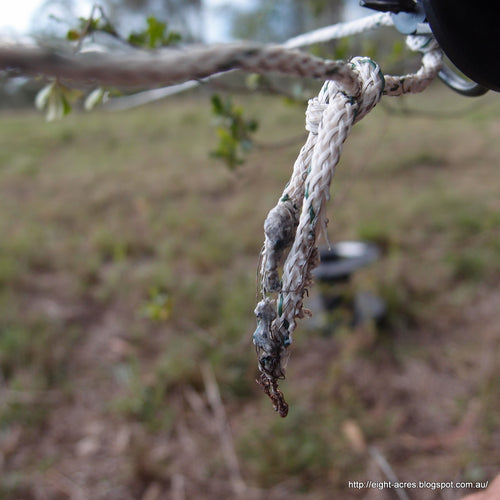Electric fencing for beginners
Electric fencing seems complicated...
We were a bit slow to start using electric fencing. It all seemed very complicated to me, which is stupid really, I did study physics at high school and university, I should be able to understand how an electric fence works! Maybe I was over-thinking it, because now we've had a bit of practice, they seem very simple and very very useful.
| Strip grazing a paddock of forage sorghum |
Electric fencing is really easy and SO useful!
For a simple temporary fence, all you need is electric fence wire or tape, fence posts or clips to attach to an existing fence, an energiser and a battery (unless you get a mains powered energiser). We usually run the wire/tape out around the area, and then position the posts at sensible intervals. We set up the earth, connect the energiser to power and turn on the fence.
| energiser on the post, attached to polywire, battery and earth stake |
Electric fence "earth" is the key
It took me a while to work out what the "earth" was for, but once you understand that, the rest of the fence makes more sense. There are two ways of setting up the fence, either using an earth return wire or all live wires and an earth stake. With the earth return wire you alternate live and earth wires.
With the earth stake, its just a metal rod in ground connected to the earth on the energiser. Some people use really long stakes, like 6 m long stakes, but we just use an old tent peg. So far we have been able to use just one or two live wires, with an earth stake. If you don't have an earth wire, you are relying on the ground to complete the circuit, which works ok if your soil is currently moist.
Either way, when an animal touches the fence and contacts both the earth (wire or literally the change going into the ground) and a live wire, they complete the electric circuit and receive a shock. The energiser itself is connected to the live wires, and to the earth wire or earth stake.
What size energiser do you need for your electric fence?
Energisers come in different sizes designed to cover different nominal distances. When you first introduce cattle to an electric fence its a good idea to use an oversized energiser for the distance you're fencing. If the first shock they ever get is a strong one, they are unlikely to touch the fence again. Cattle are very set in their ways, our house cow Bella will not touch an electric fence wire or tape, or even walk over a fence, whether it is energised or not, so we don't even have to use an energiser to keep her on the right side.
Our neighbour's goats, however, can hear when the fence is on or off and are very opportunistic if they do notice that its off. If you have a lot of vegetation touching the fence, it will drain some of the charge, so its best to oversize the energiser in this case as well.
| brafords in the sorghum, its taller than them, so they could waste it if they had the entire area at once |
This sounds silly, but we didn't know you could leave the excess wire on the reel!
Temporary electric fencing opens up a world of opportunities
- We have fenced off an eroded area of our property that needed a rest from hooves, it is making an impressive recovery
- We fence inside the house yard so that the house cows can come in and trim the grass (lawn moo-ers), this saves us mowing and lets them eat some nice green grass
- We have been strip grazing our 17 acres of forage sorghum as we haven't had very good weather for making hay. This way the cattle get a few acres at a time and don't waste as much, they are also spreading their manure over the cultivation area
| Molly trimming in the house yard, and my garden is safe behind the fence |
Where can you find out more about electric fencing?
| How to join electric fence polywire |
| How to use a solar electric fence energiser |
| How to split up paddocks using an electric fence |




















Leave a comment